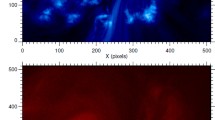Abstract
Observations with the Transition Region and Coronal Explorer, TRACE, show frequent catastrophic cooling and evacuation of quiescent solar coronal loops over active regions. We analyze this process using image sequences taken in passbands showing plasma from a few million degrees down to less than 100 000 K, taken at a cadence of 90 s. The loop evacuation often occurs after plasma high in the corona has cooled to transition-region or even chromospheric temperatures. The cooling loops frequently show Lyman-α and C iv emission developing initially near the loop tops; later, that cool plasma usually slides down on both sides of the loop. The relatively cool material often forms clumps that move at speeds of up to 100 km s−1. The downward acceleration is no more than 80 m s−2, less than \(\frac{1}{3}{\text{rd}}\) of the surface gravity. Cooling appears to progress with delays of the order of up to 103 s between thin, neighboring strands within flux bundles with cross-sections of at least 1–2 Mm, so that hot and cool loops are transiently outlined at essentially the same location. The falling material at temperatures of ≲ 0.1 MK shows no evidence of loop braiding on scales above the resolution of ∼1 Mm; loop cross-sections appear independent of height. Existing numerical models suggest that the observed catastrophic loop-top cooling in non-flaring conditions can occur if the loop heating precipitously drops by 1.5 orders of magnitude or more, first and most strongly high in the corona. Using order-of-magnitude geometrical arguments, we estimate that loop bundles in the interior of an active region undergo catastrophic cooling on average once every 2 days, while in a decayed bipolar region that time interval is approximately a week.
Similar content being viewed by others
References
Antiochos, S. K.: 1980, Astrophys. J. 236, 270.
Aschwanden, M. J., Nightingale, R. W., and Alexander, D.: 2000, Astrophys. J. 541, 1059.
Brown, S. F.: 1996, Astron. Astrophys. 305, 649.
Golub, L., Bookbinder, J. A., DeLuca, E. E., Karovska, M., Warren, H. P., Schrijver, C. J., Shine, R. A., Title, A. M., Wolfson, C. J., Handy, B. N., Kankelborg, C. C.: 1999, Phys. Plasmas 6, 2205.
Gouttebroze, P., Vial, J. C., and Tsiropoula, G.: 1986, Astron. Astrophys. 154, 154.
Habbal, S. R., Ronan, R., and Withbroe, G. L.: 1985, Solar Phys. 98, 323.
Handy, B. N., Acton, L. W., Kankelborg, C. C. et al.: 1999, Solar Phys. 187, 229.
Harrison, R. A., Fludra, A., Pike, C. D. et al.: 1997, Solar Phys. 170, 123.
Kjeldseth-Moe, O. and Brekke, P.: 1998, Solar Phys. 182, 73.
Levine, R. H. and Withbroe, G. L.: 1977, Solar Phys. 51, 83.
Mariska, J. T.: 1987, Astrophys. J. 319, 465.
Martens, P. C. H. and Kuin, N. P. M.: 1982, Astron. Astrophys. 112, 366.
Mok, Y., Drake, J. F., Schnack, D. D., and Van Hoven, G: 1990, Astrophys. J. 359, 228.
Rosner, R., Tucker, W. H., and Vaiana, G. S.: 1978, Astrophys. J. 220, 643.
Schrijver, C. J., Title, A. M., Berger, T. E. et al.: 1999, Solar Phys. 187, 261.
Watko, J. and Klimchuk, J.: 2000, Solar Phys. 193, 77.
White, S. M., Thomasand J. W., Brosius, R. J., and Kundu, M. R.: 2000, Astrophys. J. 534, 203.
Wikstøl, Ø., Judge, P. G., and Hansteen, V.: 1998, Astrophys. J. 501, 895.
Author information
Authors and Affiliations
Electronic supplementary material
Rights and permissions
About this article
Cite this article
Schrijver, C.J. Catastrophic cooling and high-speed downflow in quiescent solar coronal loops observed with TRACE. Sol Phys 198, 325–345 (2001). https://doi.org/10.1023/A:1005211925515
Issue Date:
DOI: https://doi.org/10.1023/A:1005211925515




